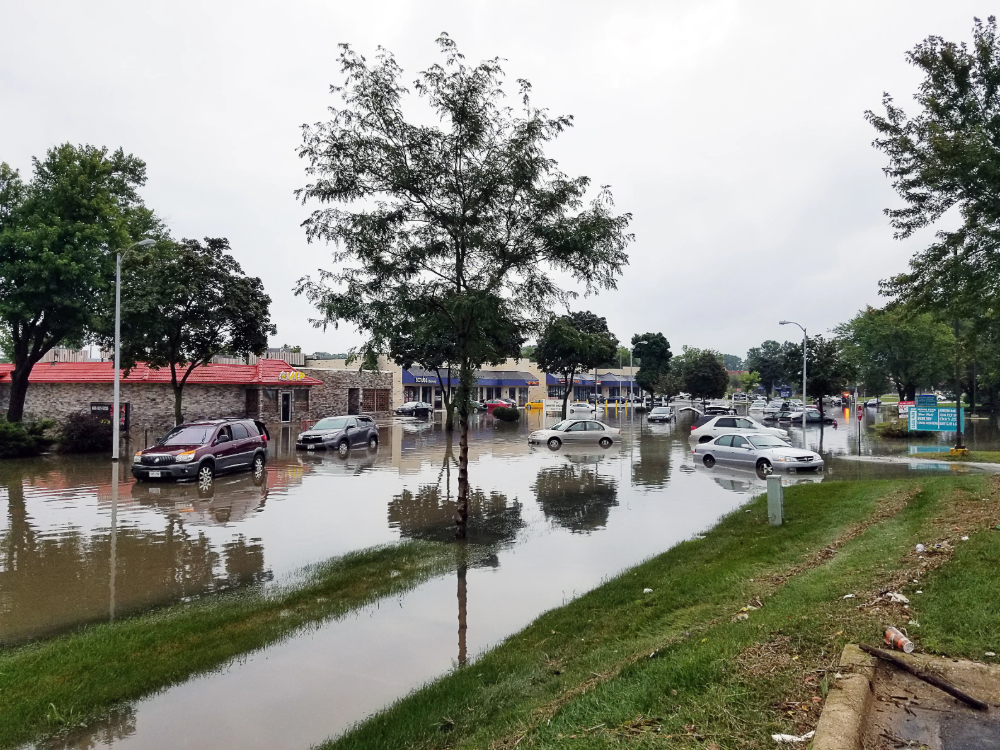Southwest Philly: the next Atlantis?
The Eastwick neighborhood of Philly could experience monthly floods as soon as 2060 — a trend experts predict many other coastal cities will face in coming years
Jenaye Johnson • July 18, 2024

Watch out: Dozens of cities, including your own, may brandish flooded streets thanks to rising sea levels. [Credit: Jim Gade | Unsplash]
Bound by water on three sides, Eastwick is no stranger to intense flooding from heavy rainstorms that have left homes damaged and lives uprooted in recent years. But flooding may get much worse: As soon as 2060, Eastwick residents could start to suffer from monthly minor floods, according to new research.
In the past, floods have come to Eastwick from tropical storms or excessive rainfall that contributed to river overflow. According to the latest models, however, things have changed. These monthly small floods on the horizon, scientists say, would originate not from the nearby rivers but from rising sea levels along the Atlantic coastline.
Climate scientists have long predicted steady incremental increases in the global sea level. A warming planet melts ice caps, heats up ocean waters and causes sea level to rise by millimeters every year. Yet knowledge behind how higher sea level could affect Eastwick or other nationwide floodplains — stretches of land that are easily susceptible to floods from nearby water sources — hadn’t been identified until now.
“It’s very easy for Eastwick to be seen as a location that just has river flooding, because that’s what has impacted Eastwick in recent decades,” said Philip Orton, a fluid engineer with the Stevens Institute of Technology and lead researcher on the new study. “But of course with further sea level rise, or with a worse coastal storm, there is potential for Eastwick to get storm surge and tide flooding. And that’s a big concern.”
Orton’s research team tracks flood pathways to make accurate models that can inform engineers and policy makers about where water is coming from, the chances of flooding and who is at risk for flood damage. They chose to focus on Eastwick after learning about its flooding issues seven years ago.
Several years into the project, the discovery arose that Eastwick’s newest obstacle came from the ocean.
“If we get three or four feet of sea level rise in the future, that will start causing flooding in Eastwick on a monthly basis,” Orton revealed.
Preventative measures to address new flood sources are already drafted: The local Eastwick government is receiving help from the Army Corps of Engineers, which is planning to build a 1,400-foot levee along the left bank of the Cobbs Creek River. But that won’t be completed for at least a few more years.
“I just want something to work,” said Theresa Knight, an elementary school counselor who has lived in Eastwick for more than 30 years. “[Officials] are just talking, there’s no one saying they’re doing it. Like, do they have a timeline? And in the meantime, another flood could hit.”
Knight, who first bought her home in the 1980s, wasn’t even aware she needed flood insurance at the time. That would come back to bite her family after a major flood in 1999 swept through the neighborhood. It took years to recover from the damage.
Unfortunately, Eastwick isn’t the only area in the U.S. predicted to experience more of these minor floods, also known as high tide flooding, in the coming years. A 2022 study predicts similar flooding will threaten communities along the East, West and Gulf coastlines over the next few decades, too. San Francisco and Miami, for example, are prime hubs on the flooding list.
“Now we have this point where [minor flooding] happens every year, in places like Miami. It happens in the fall,” said Thomas Wahl of the University of Central Florida and author of the 2022 paper. In the fall and winter, sea levels rise due to the cool weather, forcing more water to encroach on coastal areas. This phenomenon is something many port cities, like Boston and Wilmington, have become accustomed to — but that wasn’t the case just 10 or 20 years ago, Wahl said.
For Philadelphia alone, residents citywide can expect roughly 50 to 140 flood days per year by 2040. Beaufort, South Carolina, may have about 20 to 70 flood days per year in the same time frame, according to a searchable tool developed by NASA.
Knowing the type of flood and frequency is crucial for potential homeowners. Since Eastwick is built on a floodplain, all residents are required to purchase $1,000 to $2,000 flood insurance and brace themselves for any damage if rainfall gets too wild. There’s a chance this new source of flooding could lead to an uptick in insurance costs, according to Axios.
The same hundreds of homes tend to be hit by floods over and over, according to Korin Tangtrakul of Philadelphia’s Office of Sustainability — and the same people file complaints every time there’s a heavy storm. With more frequent flooding on the horizon, both Orton and Tangtrakul predict that the rate of these complaints will only rise. And even more houses will become vulnerable, bearing the brunt of recurrent flooding.
Knight is both anxious and conflicted about relocating. “I like my house, you know, and I like the neighborhood that I’m in.” But the flood she experienced in 2020 has made her think about moving. “It was never the community that I wanted to leave, it was really just the trauma of having something like that happen. It’s just so upsetting to have that much water come through.”
If flooding keeps getting worse, Knight, along with other Eastwick residents in the ever-growing flood zone, may have no choice but to move away.